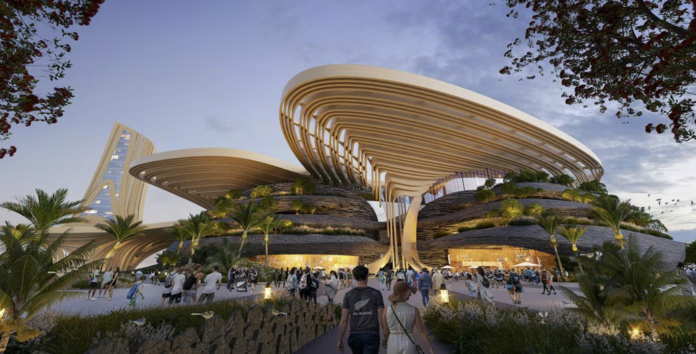The design of a proposed stadium in downtown Auckland has been released by a global team who say Auckland is in need of better stadium infrastructure. The stadium has been proposed as part of a precinct, known as Te Toangaroa, in Auckand’s Quay Park, and would also include four hotels, bars, restaurants, retail, commercial office space, apartments, public plazas and green spaces.
Former Warriors chief executive Jim Doyle, who is backing the proposal, designed by HKS Architects, says he always felt as though Auckland “deserved” better stadium infrastructure. Doyle believes the proposed stadium, which could hold around 55,000 people, would provide that.
The new stadium would be situated in Quay Park in the heart of Auckland’s CBD next to Spark Arena, and near Britomart train station and lots of other bus options. Cruise ships would also be anchored nearby on Princess and Queens Wharf, just minutes walk away. Being in downtown Auckland, the stadium is also surrounded by hospitality options for pre and post-game dining.
The design of the proposed stadium was unlike any other in Australasia, Doyle says, and HKS Architects want to help create something “unique” to Auckland and New Zealand.
Doyle says the design is “radical and innovative”, and is inspired by traditional Maori culture and historic features of the city. The arena will also be opened out at one end, allowing views of the Waitemata Harbour and Rangitoto Island.
The stadium will allow for sports and other events such as concerts to be held there, and will be able to be reconfigured to suit what event is taking place. The new design also includes a retractable roof, allowing for indoor and outdoor events to take place, irrespective of the weather.
“It’s an iconic stadium and could be used for concerts as well as sports. We wanted something that wasn’t just a concrete box looking inwards on itself,” Doyle says.
The Quay Park area where the proposed precinct would go, is largely unused, with old railway tracks. Since the building of Spark Arena in 2007, the area behind the old Auckland train station has been largely disused, making it ripe for development options.
As early as 2016, people were floating the land at Quay Park, which is owned by Ngati Whatua Orakei, as an option for a new stadium.
Several bars, restaurants, and retail outlets, as well as commercial office space and potential for residential apartment buildings, have also been included in the proposal. The regeneration of the area would be the last in a chain along the waterfront, after Wynyard Point, the Viaduct, Britomart and Commercial Bay.
The stadium proposal comes with four new hotels in the Quay Park area, including one in the form of an All Blacks-themed hotel. The hotel, which has the support of NZ Rugby, would be incorporated into the side of the stadium, and would be the first of its kind in New Zealand.
Since releasing artists’ impressions of the stadium, Doyle says feedback from the public had been “very positive”.
“It’s a striking building, and I think it’s something Aucklanders really want in their city.”
The proposal of the Quay Park precinct is one of eight bids under consideration by an Auckland Council working group. Doyle says it would then be up to the council to decide on its preference for Auckland’s future main stadium.
• Buchan, an acclaimed global architecture, interiors, masterplanning and experiential design studio, says it is proud to be working with HKS on the Auckland city-shaping project.
Led by Cenfield MXD Ltd, the consortium has brought together heavy weights in the global and local sports industry to help turn their vision into a reality.
More than a “downtown stadium” that activates the eastern approach to Auckland’s CBD, the proposed design captures the regeneration of an entire industrial neighbourhood precinct into a revitalised destination that provides genuine activation, economic and employment activity on non-event days.
With internationally-renowned sports architects HKS leading the design, the proposal reflects a deep dialogue on placemaking and culture in collaboration with partners Buchan, TOA Architects, Boffa Miskell, Aurecon, Robert Bird & Partners, Barker & Associates and Turner & Townsend.




